
 |
Utah StarsYears of existence: 1970-71 through December 1975
|
Back to "Remember the ABA" Main Page
Did you see an Utah Stars game? Or, did you have a favorite Stars player? Contribute to this web page by
(by Matt Roblez) In the summer of 1970, the Los Angeles Stars had a promising future. The previous season, the franchise had surprisingly stormed through the ABA Playoffs to the ABA Finals against the Indiana Pacers. The Stars had signed Zelmo Beaty (the All-Star NBA center) to a contract in 1968, and Beaty was eligible to begin playing for the Stars in the 1970-71 season. But, the Stars had lost a lot of money and were tired of sparse crowds at the Los Angeles Sports Arena. Faced with the choice of moving to Salt Lake City or Albuquerque, the Stars made the right choice and picked the basketball-crazy Utah city.
The official announcement was made by new owner Bill Daniels at a June 10, 1970 press conference held at the Salt Palace. Daniels, a native of Greeley, Colorado, was a cable TV pioneer and the leader of the first jet flight-demonstration team known as the Blue Angels. Daniels promised his attentive audience that the Utah Stars would become the "Green Bay Packers of professional basketball." For two reasons, Daniels' announcement immediately captured the interest and enthusiasm of Utah sports fans. First, it was felt by those in the Utah sports community that this was the first time, and possibly the last time, that a major league professional team would call Utah its home. Second, Utah was (fortunately) not receiving a throwaway last place team -- it was receiving the defending ABA Western Division Playoff Champions.
Before the first Utah Stars season, red white and blue ABA basketballs showed up at every Salt Lake City schoolyard and playground. On October 14, 1970 the Utah Stars played their first game against the Denver Rockets. The Stars defeated the Rockets 134-99 in front of a sold out Salt Palace crowd. The roster for the Stars that night was:
Coach Bill Sharman: An NBA legend with the Boston Celtics. An innovative coach who coached with a set of monetary fines and rewards based on court performance.
Zelmo "The Big Z" Beaty: Seven year NBA veteran and two time NBA All-Star
George Stone: Third year ABA veteran and one of the team's best scorers.
Tom Workman: Former teammate of Beaty with the St. Louis Hawks.
Merv "The Magician" Jackson: Former University of Utah All-American and third year ABA veteran.
Jeff "Mutt" Congdon: Former BYU cager and third year ABA veteran.
Dick Nemelka: Former BYU cager in his first pro season.
Willie Wise: Second year ABA veteran who had been named to the ABA s All-Rookie team the previous season.
Don Freeman: At the time Freeman ranked in the top 10 in eight individual ABA career categories.
"Rocket" Rod McDonald: Rookie who had earned Little All-American honors at Whitworth Junior College.
Wayne Hightower: Other than Beaty, the most experienced player on the roster.
Red Robbins: A fourth year ABA veteran and the leading scorer for the Western Division in 1969 ABA All-Star game (19 points).
Mike Butler: Third year ABA veteran. Known for his fancy dribbling between his legs and behind his back.
This original roster didn't stay the same for long. In January 1971, Freeman and Hightower were traded to the Dallas Chaparrals for Glen Combs (later to be the first pro player to average over 40% from the three point line) and Ron Boone (who would play in every single Stars game after the trade until the demise of the franchise in December 1975). The Stars ripped through the 1970-71 regular season with a record of 57-27, finishing only a single game behind the Indiana Pacers. In the first round of the 1971 playoffs, the Stars swept the Texas Chaparrals in four straight games. Next came a brutal seven game series with the Indiana Pacers. The Pacers had defeated the Stars the year before in the 1970 ABA Finals. In the 1971 series Utah gained a 3-2 series lead, but (in a heartbreaker) lost the chance to wrap up the series at home in Game 6. With their backs against the wall, the Stars flew back to Indiana for Game 7 and escaped with a remarkable 108-101 win. The Stars advanced to play the Kentucky Colonels in the 1971 ABA Championship Series.
The Kentucky series was a long, drawn-out affair which came down to a decisive Game 7 at the Salt Palace. 13,260 screaming Utah fans were present on May 18, 1971 to see whether Utah could claim the ABA title. Utah would not be denied. The Stars dominated the Colonels en route to a 131-121 victory. It took 20 minutes to clear the court of all the rabid fans who stormed onto the floor at the final buzzer. Both Willie Wise and Zelmo Beaty were carried off the floor on the shoulders of Stars fans (photo below). It was a satisfying end to a magical season that Utah fans will never forget.
For the Colonels, it was a crushing defeat. Van Vance sadly called the final seconds for the fans back in Louisville (and managed to avoid being overrun by the hundreds of Stars fans rushing the court at the final buzzer). Streaming RealAudio File - Clip courtesy of Van Vance/WHAS-AM and used with permission. |
During their first year in Utah, the Stars drew 262,342 fans to 42 regular season home games -- an average of 6,246 per game. This set a new ABA record. The most amazing thing about this record was that there were only two Saturday night and five Friday night games in the entire 42 game home schedule.
For the 1971-72 season, the defending champion Stars had a new coach -- LaDell Andersen. Anderson had coached 10 years for the Utah State Aggies in Logan, Utah, and was an advocate of the run-and-gun style of basketball. LaDell came to the Stars with a 176-96 NCAA record at USU. On October 5, 1971 the ABA Champion Utah Stars hosted the NBA Champion Milwaukee Bucks (with Lew Alcindor) in the Salt Palace. The game was dubbed the "Super Bowl of Basketball." The game was close most of the way, but eventually the Bucks overpowered the ABA Champions. Under new coach Andersen, the Stars went on to win the regular season Western Division title with a record of 60-24. As in 1971, the Stars dismissed the Dallas Chaparrals in four straight games in the first round of the playoffs. And, once again, the Stars faced their arch-rival Indiana Pacers in the Western Division finals. The series went to six games, but this time the Stars lost to the eventual champion Pacers.
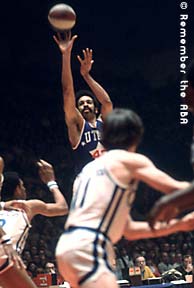 |
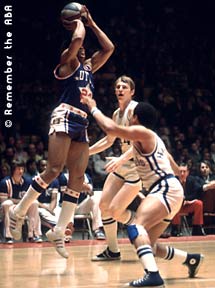 |
 |
| During the ABA's "middle" years of 1971-1974, no team had more on-court success than the Utah Stars. The Stars won the ABA Western Division title for four straight seasons, from 1970-71 through 1973-74. The only thing keeping the Stars from an ABA dynasty? Their pesky Western Division rivals, the Indiana Pacers. No matter their regular season record, the Pacers always seemed to nip the Stars in the playoffs.
The Stars had a frontcourt that was feared throughout the ABA. Willie Wise (#42, above left) was probably the ABA's best "two-way" player. Invariably, Wise would guard the other team's best offensive player (George McGinnis, Julius Erving, etc.). Wise had a consistent offensive game as well. Ron Boone (#24, above middle) was a rugged, physical player with fantastic leaping ability. He started out with the Dallas Chaparrals, but his best years were with the Stars. Zelmo "the Franchise" Beaty (#31, above right) anchored the middle year after year despite sore knees. Beaty's job was to battle the likes of Mel Daniels, Artis Gilmore and Billy Paultz. And Gerald Govan (#25, right, with the thick glasses), filled the "Dennis Rodman" role for the Stars, but without any theatrics. Govan didn't want to shoot, he just wanted to defend, block shots, and sweep the glass. |
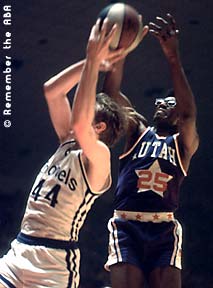 |
LaDell Andersen remained the coach for the 1972-73 season, and, as usual, the Stars got off to a great start. Salt Lake City hosted the 6th ABA All-Star Game, and Anderson coached the West to a 123-111 win over the East. The Stars finished first in the Western Division, with a 55-29 record. They defeated the upstart San Diego Q's in the first round, but were once again defeated by the Indiana Pacers in the Western Division finals (this time in seven games). At the end of the season LaDell Anderson left the team to pursue other interests.
For the 73-74 season Utah hired longtime ABA coach Joe Mullaney. Mullaney's team was disciplined and led the Stars to their third straight regular season Western Division championship. Again the Stars defeated the youthful San Diego Q's (with coach Wilt Chamberlain) in the first round of the playoffs. Finally, however, the Stars were able to squeak by the Pacers in yet another bitter, hard-fought series that went the full seven games. Utah faced the New York Nets in the ABA finals. The Nets were led by basketball legend Julius Erving and proved to be too much for the Stars. The Stars lost in five games.
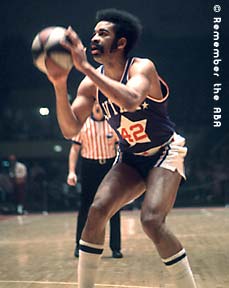 |
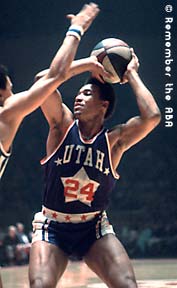 |
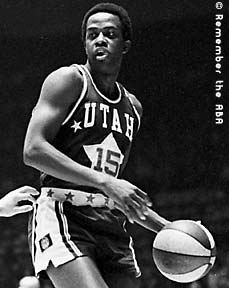 |
| All four of these Utah Stars made the recently announced All-Time ABA Team. What more can be said about Willie Wise and his five seasons with the Los Angeles/Utah Stars? Wise (#42, above left) certainly would have been a superstar in any league. He was dominant in the ABA. His first two years with the Stars, Wise averaged around 16 points per game. His next three years with the franchise, he averaged a solid 23 points per game. But since Willie played his best ball in the ABA, he never was fully appreciated by NBA loyalists.
Ron "Iron Man" Boone (#24, above center) had a spectacular ABA career. The year after the ABA/NBA merger, he averaged 22.2 points per game with the Kansas City Kings. His basketball career finally ended with the Utah Jazz in 1980-81. During the course of his 13 year career, Boone played in 1,041 straight games, a pro record. A.C. Green eventually beat Boone's mark in the late 1990's. However, unlike Green, Boone played at least 20 minutes in each of his 1,041 games. From 1971-72 through 1973-74, guard Jimmy Jones (#15, above right) ran the Utah offense. You could usually find Jones among the top five ABA assist men. At times, he was also an unstoppable scorer. In the later years of the ABA, the most famous Utah Star had to be Moses Malone (#22, left). Malone was the very first basketball player to jump from high school to the pros. As a skinny 18 year old ABA rookie in 1974-75, Malone averaged an incredible 18.8 points and 14.6 rebounds per game. He also made the ABA West All-Star team. In the 1975 Playoffs against the Denver Nuggets, Malone had several games of over 30 rebounds (many off the offensive glass). ABA fans enjoyed watching Moses for two years. Then the leagues merged, and the rugged Malone went on to score over 27,000 points in the NBA. |
Despite his team's success on the court, owner Bill Daniels was swiftly running out of money to run his franchise. For the 1974-75 season, the Stars hired Bucky Buckwalter to coach after Mullaney was let go for financial reasons. In the middle of the season, Tom Nissalke took over and led the Stars to their fifth straight playoff appearance. The Stars were defeated by the heavily favored Denver Nuggets in 6 games.
The final edition of the Utah Stars was coached by Tom Nissalke. His assistant was Del Harris (the current coach of the Los Angeles Lakers). In December of 1975, the man who brought the Stars to Utah was flat broke due to a failed attempt to become the governor of Colorado and various other failed business dealings. The Stars folded after playing only 16 regular season games. It should be noted that Mr. Daniels eventually paid all of the season ticket holders back at eight-percent interest.
Most of the Stars players were sold to the St. Louis Spirits. All of the Stars equipment and other assets were sold by public auction. It is rumored that the 1971 championship ball was sold to a man from Spanish Fork, Utah for $100.00. The Stars last coach, Tom Nissalke, still has the ball used in the last Utah Stars game (ironically, against the Spirits of St. Louis) in a box in his closet. The Stars' uniforms were sold to a local church for use in its basketball program.
Despite their ultimate demise, the Utah Stars were proof that a professional basketball team could thrive in a small market. Without the Utah Stars, the Utah Jazz NBA franchise would never have existed.
 Stars 1970-71 Home Uniform |
Stars 1972-74 Home Uniform |
Stars 1972-74 Road Uniform |
Stars 1974-75 Home Uniform |
Stars 1974-75 Road Uniform |
Stars 1975-76 Home Uniform |
Stars 1975-76 Road Uniform |
1970-71 Season
Record: 57-27, Second Place in Western Division
1971 Playoff Results:1971 Western Division Semifinals vs. Texas Chaparrals (30-54)
Stars won series, 4-01971 Western Division Finals vs. Indiana Pacers (58-26)
Stars won series, 4-31971 ABA Championship vs. Kentucky Colonels (44-40)
Stars won ABA Championship, 4-3
Record: 60-24, First Place in Western Division
1972 Playoff Results:1972 Western Division Semifinals vs. Dallas Chaparrals (45-39)
Stars won series, 4-01972 Western Division Finals vs. Indiana Pacers (47-37)
Pacers won series, 4-3
Record: 55-29, First Place in Western Division
1973 Playoff Results:1973 Western Division Semifinals vs. San Diego Conquistadors (30-54)
Stars won series, 4-01973 Western Division Finals vs. Indiana Pacers (51-33)
Pacers won series, 4-2
Record: 51-33, First Place in Western Division
1974 Playoff Results:1974 Western Division Semifinals vs. San Diego Conquistadors (37-47)
Stars won series, 4-21974 Western Division Finals vs. Indiana Pacers (46-38)
Stars won series, 4-31974 ABA Championship vs. New York Nets (55-29)
Nets won series, 4-1
Record: 38-46, Fourth Place in Western Division
1975 Playoff Results:1975 Western Division Semifinals vs. Denver Nuggets (65-19)
Nuggets won series, 4-2
Record: 4-12, Folded on December 2, 1975